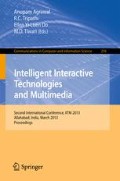Abstract
This paper presents an integration technique for extraction of Information from high resolution satellite image and also demonstrates the accuracy achieved by the final extracted information. The integration technique comprises of an improved mathematical morphology based watershed transform and a non-linear derivative method. It overcomes all the disadvantages of existing region based and edge based methods by incorporating aforesaid integration methods. It preserves the advantages of multi-resolution and multi-scale gradient approaches. Using these approaches, it avoids excessive fragmentation into regions. The watershed segmentation is proved to be a powerful and fast technique for both contour detection and region-based segmentation. In principle, watershed segmentation depends on ridges to perform a proper segmentation, a property that is often fulfilled for contour detection where the boundaries of the objects have been expressed as ridges. On the other hand, the non-linear derivative method is used for resolving the discrete edge detection problem. Since it automatically selects the best edge localization, which is very much useful for estimation of gradient selection. The main benefit of univocal edge localization is to provide a better direction estimation of the gradient, which helps in producing a confident edge reference map for synthetic images. This nonlinearity will effectively improve global filtration process and regarded to be an effective technique for regularization in order to provide information extraction in a valid manner. The practical merit of this proposed method is to derive an impervious surface from emerging urban areas. Hence this proposed method gives a major contribution in the field of satellite image for information extraction.
Access this chapter
Tax calculation will be finalised at checkout
Purchases are for personal use only
Preview
Unable to display preview. Download preview PDF.
References
Kim, J.B., Kim, H.J.: Multiresolution-based watersheds for efficient image segmentation. Pattern Recognition Letters 24(1-3), 473–488 (2003)
Laligant, O., Truchetet, F., Meriaudeau, F.: Regularization Preserving Localization of Close Edges. IEEE Signal Processing Letters 14(3), 185–188 (2007)
Parvati, K., Rao, B.S.P., Das, M.M.: Image Segmentation Using Gray Scale Morphology and Marker Controlled Watershed Transformation. Discrete Dynamics in Nature and Society, Article ID 384346, 8 pages(2008), doi:10.1155/2008/384346
Liu, J., Yang, Y.H.: Multiresolution Color Image Segmentation. IEEE Transactions on Pattern Analysis and Machine Intelligence Archive 16(7), 689–700 (1994)
Meinel, G., Neubert, M.: A comparison of segmentation programs for high resolution remote sensing data. In: Proceedings of the 20th International Archives of Photogrammetry and Remote Sensing (ISPRS) Congress, XXXV(Part B), Istanbul, Turkey, pp. 1097–1102 (2004)
Shackelford, A.K., Davis, C.H.: A combined fuzzy pixel-based and object-based approach for classification of high-resolution multispectral data over urban areas. IEEE T. Geoscience and Remote Sensing 41(10), 2354–2363 (2003)
Rizvi, I.A., Mohan, B.K., Bhatia, P.R.: Multi-resolution segmentation of high-resolution remotely sensed imagery using marker-controlled watershed transform. In: ACM Proceedings of the International Conference Workshop on Emerging Trends in Technology (ICWET 2011), vol. 14(9), pp. 674–678. TCET, Mumbai (2011)
Rizvi, I.A., Mohan, B.K.: Object-Based Image Analysis of High-Resolution Satellite Images Using Modified Cloud Basis Function Neural Network and Probabilistic Relaxation Labeling Process. IEEE T. Geoscience and Remote Sensing 49(12), 4815–4820 (2011)
Laligant, O., Truchetet, F.: A Nonlinear Derivative Scheme Applied to Edge Detection. IEEE Transactions on Pattern Analysis and Machine Intelligence 32(2), 242–257 (2010)
Author information
Authors and Affiliations
Editor information
Editors and Affiliations
Rights and permissions
Copyright information
© 2013 Springer-Verlag Berlin Heidelberg
About this paper
Cite this paper
Singh, P.P., Garg, R.D. (2013). Information Extraction from High Resolution Satellite Imagery Using Integration Technique. In: Agrawal, A., Tripathi, R.C., Do, E.YL., Tiwari, M.D. (eds) Intelligent Interactive Technologies and Multimedia. IITM 2013. Communications in Computer and Information Science, vol 276. Springer, Berlin, Heidelberg. https://doi.org/10.1007/978-3-642-37463-0_24
Download citation
DOI: https://doi.org/10.1007/978-3-642-37463-0_24
Publisher Name: Springer, Berlin, Heidelberg
Print ISBN: 978-3-642-37462-3
Online ISBN: 978-3-642-37463-0
eBook Packages: Computer ScienceComputer Science (R0)

